
| |coriolis_force| | |barotropic| | |baroclinic| | |advection| | |diffusion| | |turbulence| | |friction| | |stratification| |

| |coriolis_force| | |barotropic| | |baroclinic| | |advection| | |diffusion| | |turbulence| | |friction| | |stratification| |
The Coriolis force is not a "real" force; it is an apparent force which is needed to account for the fact that we observe things in (and solve the equations of motion for) the reference frame of the rotating earth as opposed to a reference frame fixed in space. Since the earth is in solid body rotation, a particle near the equator will have to travel faster to complete a 360° rotation in 24 hrs than a particle near the pole. If you shot a missile due north from near the equator, it would carry with it the eastward momentum from that latitude. As it traveled northward above the earth it would retain that eastward momentum while the earth below it would have less eastward momentum, so it would land at a longitude east of where it was launched. So while to an observer in outer space the missile would appear to have traveled in a straight line, to an observer on earth the missile would appear to have curved to the right.
Now if we consider a missile shot due east along a line of latitude, to an observer on the earth it will appear that the missile is being deflected outward (perpendicular to the axis of the earth’s rotation) away from the earth. If we decompose that outward velocity into perpendicular, or orthogonal, components one of which is locally vertical and one of which is locally north-south we see that there is a southward component to the velocity, so the missile is deflected to the right in our frame of reference. We generally don’t have to worry about the vertical component of the Coriolis force in oceanography and meteorology because it is so small in comparison to gravity, which acts in the same direction. The Coriolis force always acts to deflect things in motion (like air and water) to the right in the northern hemisphere and to the left in the southern hemisphere.
The following 3 figures, courtesy of David J. Van Domelen (Ohio State University, Department of Physics), are from www.physics.ohio-state.edu/~dvandom/Edu/newcor.html.
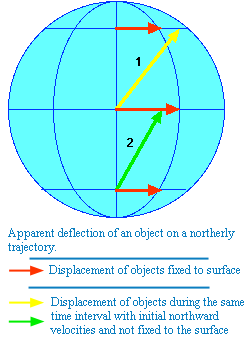
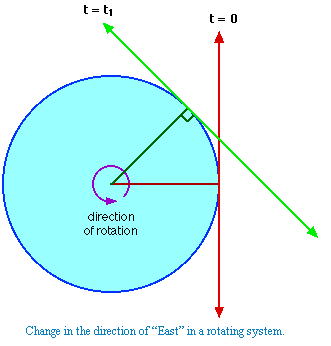
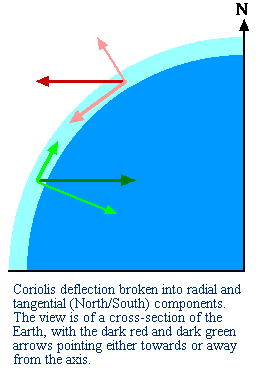
The barotropic pressure gradient and barotropic velocity are that part of the pressure gradient and velocity fields that are due to slopes in the sea surface. The barotropic pressure gradient is independent of depth in the water column, as is the barotropic velocity, except to the extent that it is influenced by friction. Neglecting friction, the barotropic velocity exhibits no vertical shear.
When the surfaces of constant density (isopycnal surfaces) are not everywhere parallel to the surfaces of constant pressure (isobaric surfaces), the density field can modify the pressure gradient such that it varies with depth. The baroclinic pressure gradient is that part of the pressure gradient that is due to the fact that surfaces of constant density are not everywhere parallel to surfaces of constant pressure. The baroclinic velocity is that part of the velocity which results from the baroclinic pressure gradient. A homogeneous (density constant with depth) body of water is always barotropic–-it doesn’t have an internal density field to generate baroclinicity. A stratified (density varies with depth) body of water may develop a pressure gradient that is purely barotropic, purely baroclinic, or most commonly a mixture of both.
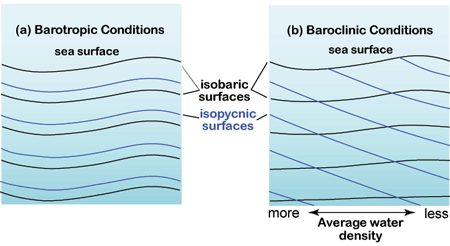
| Advection is the term used to describe the transport of a property, like relative humidity or salinity, by organized flow. In order for there to be advection, there must be a gradient in the property and a component of flow across the gradient. For instance, let’s say the salinity varies in the north-south direction, but the flow is strictly east-west, then there is no salt advection. | 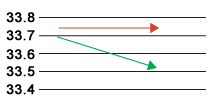 |
In the image above, if the velocity is along the red arrow there will be no salt advection; if the velocity is along the green arrow there will be salt advection.
Diffusion is the spread of properties or material by random motions in the fluid. These random motions occur on molecular scales and are accounted for in the equations of motion by using a term including the gradient in the property and a coefficient of diffusion called molecular diffusivity.
| The dimensions of diffusivity are mass per length times time, M/(LT), and the values differ for velocity, heat, and salinity.
The molecular diffusivity for velocity is also called viscosity, or
dynamic viscosity, and is denoted by
The viscosity divided by the density is called the kinematic viscosity,
|
 |
The molecular diffusivities for heat and salt are generally denoted by
 . .
|
In the ocean, as in the atmosphere, there is also random motion on larger scales that causes diffusion. This is called turbulence and is parameterized with a turbulent or eddy diffusivity or viscosity, analogous to the molecular diffusivity or viscosity. The eddy viscosity, also called the Austausch coefficient, is usually denoted Ah for the horizontal motions and Az or Av for the vertical motions. It has dimensions of L2/T, like the kinematic viscosity. The eddy diffusivity is many times larger than the molecular diffusivity. Unlike the molecular diffusivities, the eddy diffusivities are generally treated as being of equal value for all properties, such as heat, salt, and velocity, but they are dependent on direction with the horizontal eddy diffusivity being many times larger than the vertical eddy diffusivity.
In numerical models, motions occurring on scales smaller than the model grid scale are usually parameterized by a "turbulence closure scheme". These will be discussed further in the numerical modeling module of this course. See parameterizations for turbulence below.
A classic example of a turbulent flow is smoke from a cigarette. As it leaves the cigarette, it is laminar but some distance away it becomes chaotic and eventually dissipates. Oceanic flow is almost always turbulent, and this turbulence can be envisioned as small-scale eddies. The interaction of these rapidly fluctuating components of velocity is referred to as the eddy stress, or Reynolds stress, named for the person who described it this way. The spatial variations in this stress give rise to the viscous forces, or turbulent friction. Friction is a force that acts to dissipate, or slow down, the flow in the ocean. Turbulence also contributes to mixing in the ocean. Because it is very difficult (but not impossible) to directly measure or model the turbulence in the ocean, it is often parameterized in terms of the "mean" flow, an average over a short time period. This is usually done through the use of a coefficient, the eddy diffusivity (defined above), multiplied by the second spatial derivative of the mean flow, which is a measure of how the gradient of the velocity changes in space. Hence these terms may also be called the eddy diffusion or dissipation terms. The turbulent dissipation is almost always much greater than the molecular dissipation in the ocean, so the latter is usually ignored.
In addition to the turbulent friction acting in the interior of the fluid, it is important to consider the friction at the top and bottom surfaces of the ocean. These surface and bottom stresses must be known, or estimated, since they represent forces accelerating or decelerating the interior flow. Just as the wind stress is often parameterized as a function of the square of the wind speed and a drag coefficient, the bottom stress is usually parameterized as a function of the interior flow and a drag coefficient that is a function of the bottom roughness. In the simplest cases, a linear or quadratic relationship between the interior "mean" flow and the bottom stress would be used, but in more realistic cases, a more complicated formulation could be used. One can see that through the bottom stress, there is potential feedback among the surface wave field, the lower frequency interior velocity, and sediment transport. This is one reason to consider coupling wave models, circulation models, and sediment transport models.
Stratification is a measure of how much the density of the water changes with depth. More highly stratified water has a greater change of density with depth. The term stratification may also be used to apply to vertical gradients of temperature, salinity, or other variables if so stated. The part of the water column where the change of temperature with depth is the greatest is called the thermocline, similarly for the halocline but with reference to salt, and pycnocline for density.
Continue on to the next section in Module 1: Tides: Concepts and Terminology